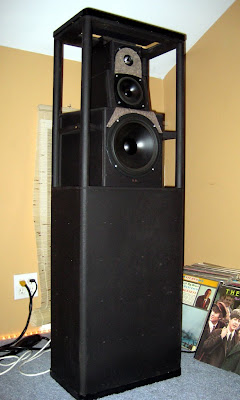A few years back, I started this thread, which was basically dedicated to the idea that we can control the directivity of a loudspeaker with both waveguides AND the shape of the enclosure.
Are you not doing unity horns anymore? The insane 3D printed stuff made of cheap drivers looked to measure well, and it solves the vertical off-axis problem nicely.
ok, but what is the speaker on the right? seems to have a large dome as tweeter!?? 🙂Mitch asked a question in another thread which I think is the most interesting debate in audio right now:
In a nutshell, if two loudspeakers measure the same, why do people have a subjective preference for direct radiators?
Here's some background on this question, from my own perspective:
Seventeen years ago, I worked for one of those failing dot com companies. We didn't have any business, so I would show up to work and study patents all day long. It was a way to kill time and appear to be busy. Just sit at my desk staring at a technical doc for eight hours that looked like engineering work. That's when I started learning about horns, Tom Danley's stuff, Keele's stuff, etc.
I've built a ton of speakers over the years, nearly all with a horn or waveguide, but there's a consistent problem with nearly every one:
They can sound great with great recordings, but with bad recordings they sound mono.
Here's an example of what I mean:

A few years back, I rented some Danley SH50s. They have a fairly flat frequency response and they're really well behaved in the phase domain.

My reference speakers are Vandersteen. They have a fairly flat frequency response and they're really well behaved in the phase domain.
The Danley speakers cost about 20X as much as the Vandersteens. You can find the latter on Craigslist for $300, easily.
On an excellent recording, the SH50s were breathtaking. For instance, you can turn the lights off and put on a track with a really great soundstage, and the SH50 is one of those speakers where the image is almost holographic. Where the center is so solid it sounds like you have a center channel, and you can almost get a sense of "front to back" depth. The dynamics are far beyond anything you would ever need in a home.
The Vandersteen can't reach those highs, the stage is never as well defined and the dynamic limits are nowhere near as high.
But here's the crazy part - on most recordings, the Vandersteen's image sounds bigger than the SH50.
This is particularly noticeable if you listen to crummy recordings. I basically listen to podcasts, EDM, some 80s music, and some punk rock. I don't listen to jazz, or orchestral, or classical.
My 'hunch' is that the much wider directivity of the Vandersteens is 'lighting up' the room in a way that the SH50s can't. Basically the Vandy's can't extract all the information in a really good recording the way that the SH50s can, but the Vandy's are also 'glossing over' the bad qualities of many recordings.
I've built a lot of Unity horns for my car, and ran into a similar issue:
There were some recordings that sounded bigger than the car itself, but there were also many recordings where it sounded like I had a mono speaker sitting in the center of my dash. It's like buying a 2160P HDTV, then realizing that a lot of your favorite movies were filmed with a potato.
That is a foam insert plugged into the horn, and those are the Summa speakers ( Geddes design)
Re-reading this thread, I come across a post I made 4 years ago...
Wow. I got that wrong. It is very challenging to achieve the right balance of direct FR and sound power FR. It is challenging regardless of the technology used, waveguides, horns, MEH, direct radiators, coaxial, dipoles, line arrays. It is always a challenge.
Very interesting post, Patrick. I think I agree, and it explaines something I have noticed: Designers of horns and wave guide speakers usually obsess over power response, and they should... It is hard to get the power response right with horns and wave guides.
But designers of direct radiator systems tend to view power response response as secondary to on-axis FR and off-axis horizontal FR. And this makes sense... With good design practice, IMO it is relatively easy to get an acceptable power response.
Wow. I got that wrong. It is very challenging to achieve the right balance of direct FR and sound power FR. It is challenging regardless of the technology used, waveguides, horns, MEH, direct radiators, coaxial, dipoles, line arrays. It is always a challenge.